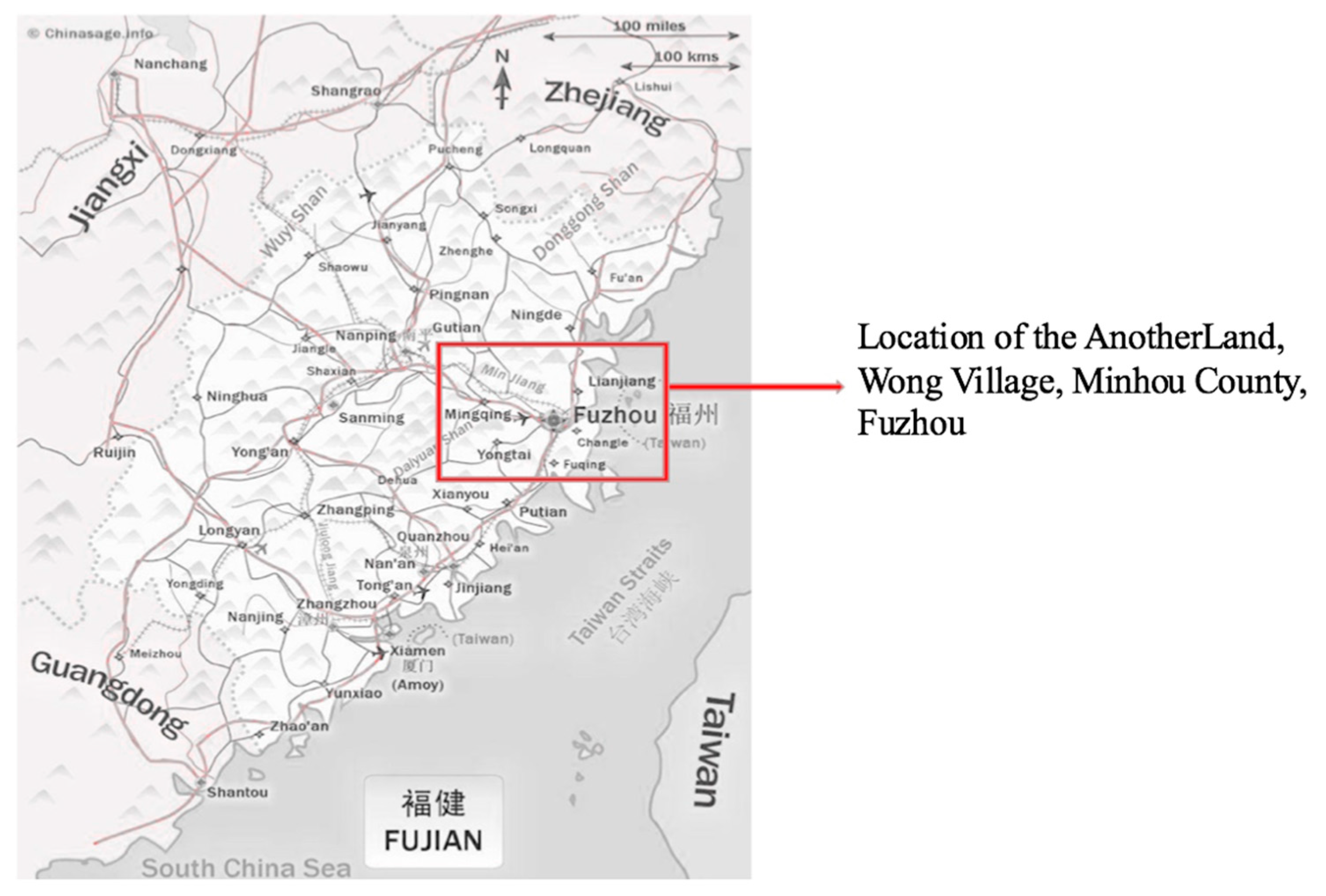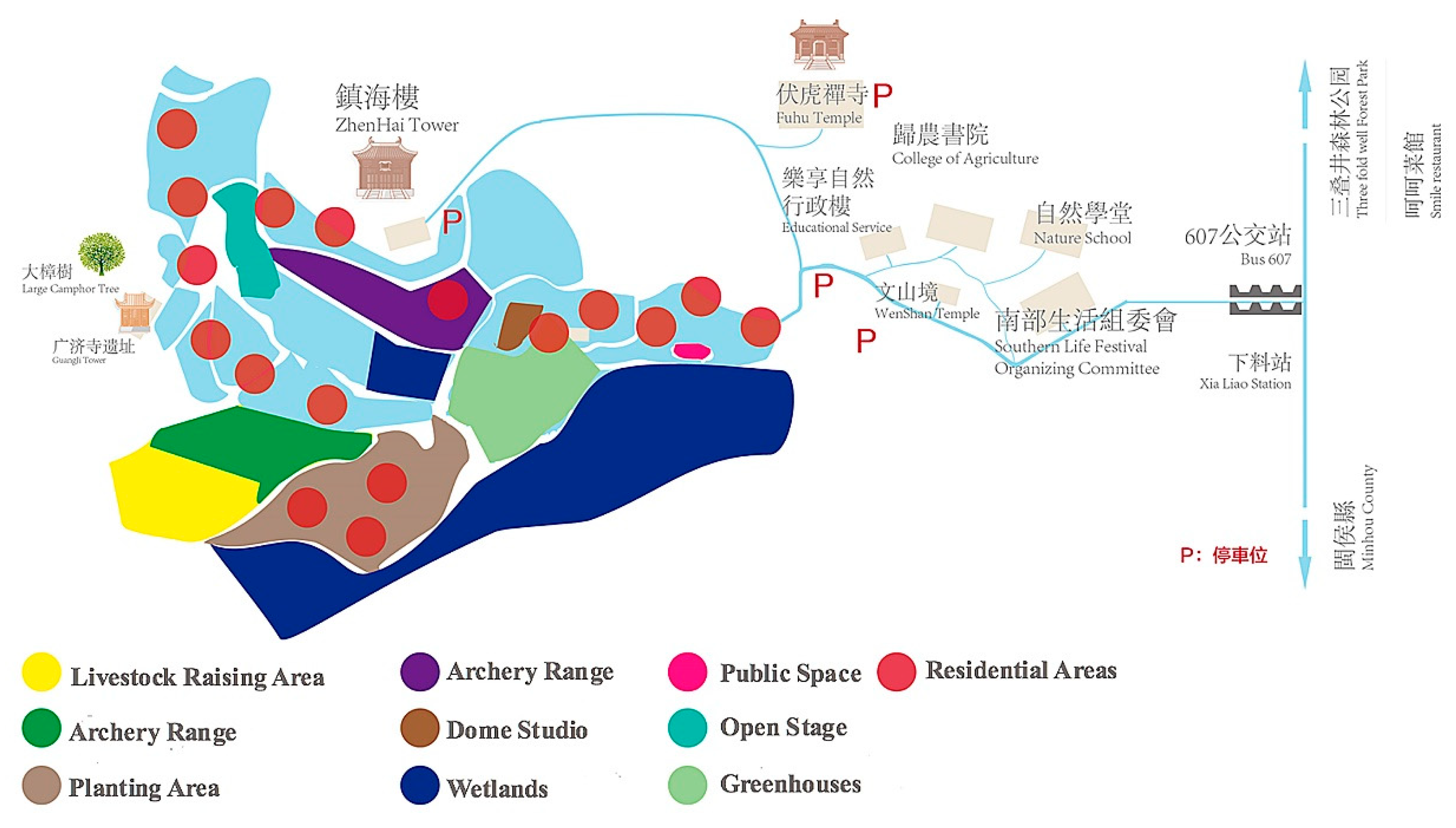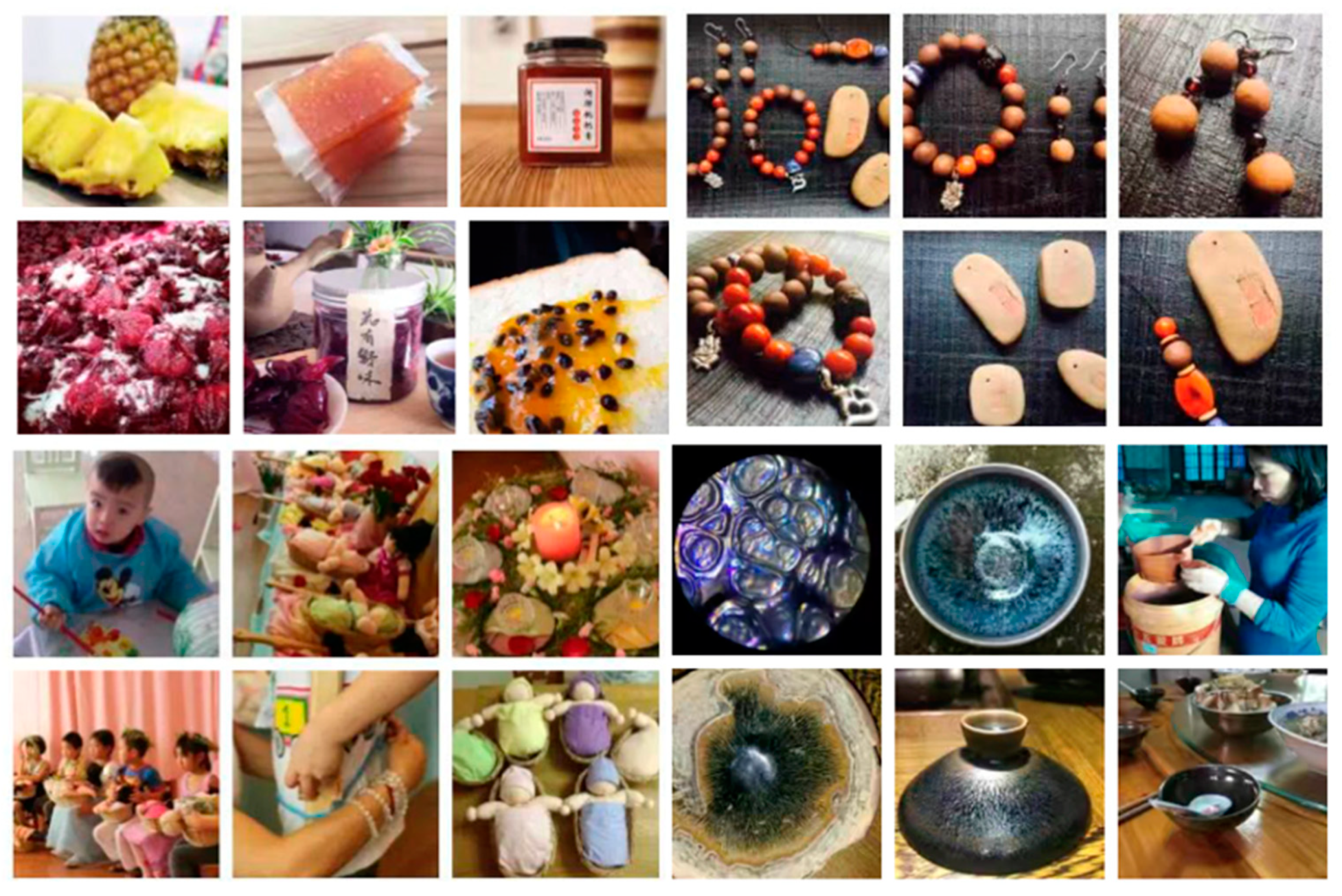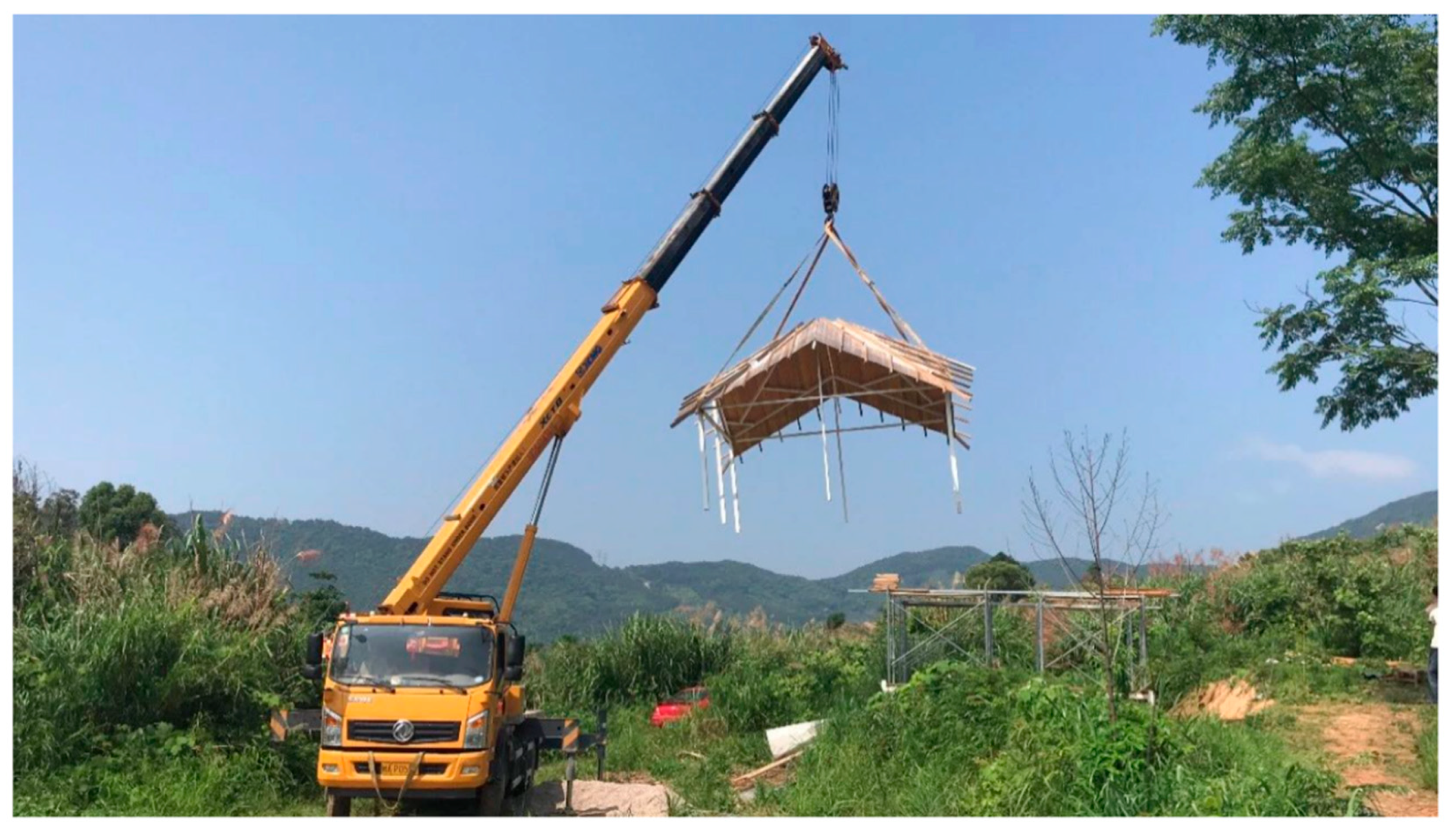Sustainability and Resilience of Alternative Lifestyles: An Ethnography of Self-organizing Communities in South China
Abstract
1. Introduction
2. Literature Review
2.1. Sustainability and Self-Organizing Communities
2.2. Eco-Villages and Co-Housing
3. Methodology
3.1. Data Collection
3.2. Description of A Self-Organizing Community
4. Results
4.1. Experiments of Specific Lifestyles
4.1.1. Organic Farming
Our (urban people) choice of food depends on suppliers like supermarkets and restaurants. I often feel anxious because I don’t know how the food is produced, even though they usually look clean. So, it is necessary to shorten the food miles (the distance from the field to the table). My solution is to grow vegetables for my family. Now I have a fixed timetable to take care of the garden. I can follow their growth process and make sure that the food served on my table is reliable. (Tong, 38)
4.1.2. Natural Education
Nature-deficit disorder is a common problem for children in the city nowadays. It refers to the lack of natural exploration and experience in their growth. It will affect children’s perceptivity, aesthetic and intellectual development. Children in the countryside can have more opportunities to get close to animals and plants, and even learn some agricultural knowledge from rural people. This part of knowledge is acquired through the mainstream education system. I think children who grow up in a natural environment tend to have a happier childhood and a more positive personality. Their physical and mental health is more important than anything else. (Spring, 37)
4.1.3. Lifestyle Transformation
I do believe nature is an extension of our body and mind. When I was farming, I feel so touched to see things grow out of the ground. I think it is a spiritual comfort that can bring vitality and hope to the cultivator. I would like to admit that my attitude towards material [things] has also changed. I used to have an excessive pursuit of material life that can be quite extravagant and wasteful. Rural life contains many philosophies that teach me to respect the land, cherish the labor, and treasure the food. So, the degree of life satisfaction in this type of self-organizing communities is very high. (Jane, 34)
4.2. Social Networks
4.2.1. Economic Activities and Scale Effect
4.2.2. Interaction with the Locals
4.2.3. Responses to the Policy of New Rurality
5. Discussion
In the process of considering what constitutes success, it was essential to consider the extent to which communities are capable of changing over time to adjust to the changed needs of the community, its members, and the wider society.[17]
Author Contributions
Funding
Conflicts of Interest
References
- Moran, E.F. People and Nature: An Introduction to Human Ecological Relations; John Wiley & Sons: Hoboken, NJ, USA, 2016. [Google Scholar]
- Moylan, T. Demand the Impossible: Science Fiction and the Utopian Imagination; Methuen: New York, NY, USA, 1986. [Google Scholar]
- Sargisson, L. Sustainability and the Intentional Community: Green Intentional Communities. In The Transition to Sustainable Living and Practice; Emerald Group Publishing Limited: Bingley, UK, 2009; Volume 4. [Google Scholar]
- Davis, J.C. Utopia and the Ideal Society; Cambridge University Press: Cambridge, UK, 1981. [Google Scholar]
- Levitas, R. The Concept of Utopia. Cap. Class 1990, 14, 158–161. [Google Scholar]
- Sargent, L.T. Three faces of utopianism revisited. Utop. Stud. 1994, 5, 1–37. [Google Scholar]
- Meltzer, G. Sustainable community, learning from the cohousing model; Trafford publishing: Bloomington, IN, USA, 2005. [Google Scholar]
- Gardner, H. The Children of Prosperity: Thirteen Modern American Communes; St Martin’s Press: New York, NY, USA, 1978. [Google Scholar]
- O’Reilly, K. Intra-European Migration and the Mobility-Enclosure Dialectic. Sociology 2007, 41, 277–293. [Google Scholar] [CrossRef]
- Qiu, S.; Liang, K. Study on Ecological Security Evaluation of Idle Farmland in Minhou County. Chin. J. Agric. Resour. Reg. Plan. 2018, 39, 93–98. [Google Scholar]
- Agyeman, J. Sustainable Communities and the Challenge of Environmental Justice; NYU Press: New York, NY, USA, 2005. [Google Scholar]
- Fernando, J.L. The Power of Unsustainable Development: What Is to Be Done? (Preface) (Author Abstract). Ann. Am. Acad. Political Soc. Sci. 2003, 590, 6–34. [Google Scholar] [CrossRef]
- Bebbington, A. Social Capital and Rural Intensification: Local Organizations and Islands of Sustainability in the Rural Andes. Geogr. J. 1997, 163, 189–197. [Google Scholar] [CrossRef]
- Christensen, K.; Levinson, D. Encyclopedia of Community: From the Village to the Virtual World; Sage Publications: California, CA, USA, 2003. [Google Scholar]
- Metcalf, B. The Findhorn Book of Community Living; Findhorn Press: Moray, Scotland, 2004. [Google Scholar]
- Lockyer, J.P. The Sustainability and Utopianism. Ph.D. Thesis, UGA, Athens, GA, USA, 2007. [Google Scholar]
- Sargisson, L.; Sargent, L.T. Living in Utopia: New Zealand’s Intentional Communities; Ashgate: Aldershot, UK, 2004. [Google Scholar]
- Karen, C.; David, L. Encyclopedia of Community: From the Village to the Virtual World. Ref. Rev. 2005, 19, 24–25. [Google Scholar]
- Xin, L. “Ling Pi Xi Jing” De She Hui Gai Zao: Xin Cun Yun Dong Yu Min Guo Zao Qi Du Shu Ren De Xiang Cun Xiang Xiang. Soc. Sci. Res. 2016, 2, 159–173. [Google Scholar]
- Kozeny, Geoff. In Community, Intentionally. In Communities Directory; Fellowship for Intentional Community, Ed.; Fellowship for Intentional Community: Rutlege, MO, USA, 2005; pp. 12–17. [Google Scholar]
- McCamant, K.; Durrett, C. Creating Cohousing: Building Sustainable Communities; New Society Publishers: Gabriola Island, BC, Canada, 2011. [Google Scholar]
- Holleman, M. Individuality in Community at the EVI. Master’s Thesis, VU University, Amsterdam, The Netherlands, 2011. [Google Scholar]
- Liftin, K. Reinventing the future: The global ecovillage movement as a holistic knowledge community. In Environmental Governance: Power and Knowledge in a Local-Global World; Kutting, G., Lipschutz, R., Eds.; Routledge: London, UK, 2009; pp. 124–142. [Google Scholar]
- Gesota, B. Ecovillages as Models for Sustainable Development: A Case Study Approach. Master’s Thesis, Albert-Ludwigs-Universitat, Freiburg, Germany, 2008. [Google Scholar]
- Kusakabe, E. Advancing Sustainable Development at the Local Level: The Case of Machizukuri in Japanese Cities. Prog. Plan. 2013, 80, 1–65. [Google Scholar] [CrossRef]
- Creswell, J.W. Research Design: Qualitative & Quantitative Approaches; SAGE: Thousand Oaks, CA, USA; London, UK; New Delhi, India, 1994. [Google Scholar]
- Marcus, G.; Fischer, M. Anthropology as Cultural Critique: An Experimental Moment in the Human Sciences, 2nd ed.; University of Chicago Press: Chicago, IL, USA; London, UK, 1999. [Google Scholar]
- Matthews, H.; Taylor, M.; Sherwood, K.; Tucker, F.; Limb, M. Growing-up in the Countryside: Children and the Rural Idyll. J. Rural Stud. 2000, 16, 141–153. [Google Scholar] [CrossRef]
- Aron, L.Y. An Overview of Alternative Education; First in a Series of Papers on Alternative Education for the U.S. Department of Labor; The Urban Institute: Washington, DC, USA, 2006. [Google Scholar]
- Leander, K.; Phillips, N.; Taylor, K. The Changing Social Spaces of Learning: Mapping New Mobilities. Rev. Res. Educ. 2010, 34, 329–394. [Google Scholar] [CrossRef]
- Bi, T.-Y. On the Bourdieu’s Theory of Field-Habitus. Acad. Explor. 2004, 1, 32–35. [Google Scholar]
- Bourdieu, P.; Wacquant, L. An Invitation to Reflexive Sociology; Polity: Cambridge, UK, 1992. [Google Scholar]
- Leonard, P. Landscaping Privilege. Being British in South Africa; Twine Andardener, F.W., Geographies of Privilege, Eds.; Routledge: London, UK, 2013; pp. 97–121. [Google Scholar]
- Urquijo, P.; Bocco, S.; Boni-Noguez, G. New rurality and the experience of place: The small rural locality of La Niña, Buenos Aires, Argentina. GeoJournal 2018, 83, 1301–1315. [Google Scholar] [CrossRef]
- Peng, H.; He, R.; Weng, X. Collaborative governance model of tourism urbanization in rural areas: A case study of Shuiji village in Taining County, Fujian. Geogr. Res. 2018, 37, 25–40. [Google Scholar]
- López, V.T. Agroindustrialización y Nueva Ruralidad en América Latina. Una reflexión para la comprensión de la realidad rural contemporánea. Estud. Rural. 2013, 1, 11. [Google Scholar]
- Burkham, J. The City Will Come to Us: Development Discourse and the New Rurality in Atotonilco El Bajo, Mexico. J. Lat. Am. Geogr. 2012, 11, 25–43. [Google Scholar] [CrossRef]
- Kay, C. Reflections on Latin American Rural Studies in the Neoliberal Globalization Period: A New Rurality? Dev. Chang. 2008, 39, 915–943. [Google Scholar] [CrossRef]
- Metcalf, W.J. Intentional Communities in Australia and New Zealand. In Encyclopedia of Community: From the Village to the Virtual World; Christensen, K., Levinson, D., Eds.; Sage Publications: Thousand Oaks, CA, USA, 2003; Volume 2, pp. 705–711. [Google Scholar]





| Pseudonym | Gender | Age | Marital Status | Length of Stay |
|---|---|---|---|---|
| Tang | Male | 29 | Married | 6 years |
| Jane | Female | 34 | Married | 5 years |
| King | Male | 32 | Single | 3 years |
| Tong | Female | 39 | Married | 3 years |
| Ceng | Male | 42 | Divorced | 8 months |
| Sherry * | Female | 29 | Single | 11 months |
| Rong * | Male | 28 | Single | 2 years |
| Park | Male | 34 | Single | 2.5 years |
| Gold | Male | 27 | Single | 4 years |
| Kuan | Male | 38 | Married | 2 years |
| Spring | Female | 37 | Married | 2 years |
| Ice | Female | 26 | Single | 4 months |
| Dou | Female | 40 | Divorced | 1.5 months |
| Tiger | Male | 30 | Single | 6 months |
| Zen | Female | 43 | Married | 5 years |
| Fan* | Female | 27 | Single | 4 years |
| Yu | Male | 57 | Divorced | 3 years |
| Kobe * | Male | 25 | Single | 3 months |
© 2020 by the author. Licensee MDPI, Basel, Switzerland. This article is an open access article distributed under the terms and conditions of the Creative Commons Attribution (CC BY) license (http://creativecommons.org/licenses/by/4.0/).
Share and Cite
Wang, P. Sustainability and Resilience of Alternative Lifestyles: An Ethnography of Self-organizing Communities in South China. Sustainability 2020, 12, 1454. https://doi.org/10.3390/su12041454
Wang P. Sustainability and Resilience of Alternative Lifestyles: An Ethnography of Self-organizing Communities in South China. Sustainability. 2020; 12(4):1454. https://doi.org/10.3390/su12041454
Chicago/Turabian StyleWang, Peng. 2020. "Sustainability and Resilience of Alternative Lifestyles: An Ethnography of Self-organizing Communities in South China" Sustainability 12, no. 4: 1454. https://doi.org/10.3390/su12041454
APA StyleWang, P. (2020). Sustainability and Resilience of Alternative Lifestyles: An Ethnography of Self-organizing Communities in South China. Sustainability, 12(4), 1454. https://doi.org/10.3390/su12041454




